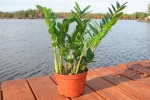Having the scientific name of ‘Zamioculcas zamiifolia’ and some synonymous names such as ‘Z. lanceolata, Z. zamiaefolium Caladium’, this plant is known as being part of the great Araceae family originated from Zanzibar.

The ‘ZZ Plant’ was introduced in Europe in 1828; it quickly conquered an important place in the category of exotic decorative plants. The reason, easy to understand, is by looking to the foliage, consisting of long nerves which are located in 5 to 12 pairs of leaflets (small leaves) thick and waxy, oval, deep green and glossy.
Considered to be a faithful follower of prehistoric plants, these indoor plants have adapted over time to a wide range of climatic vicissitudes, getting to tolerate the most diverse climate conditions.
It is estimated to develop exceptionally around a bright light in sunny areas (With about 4-5 hours of morning sun). The ZZ Plants could tolerate without effort a semi-shaded position or even the artificial light.
They accept large variations of temperature, having a well developing at a temperature somewhere between 18 and 24 degrees Celsius; it may tolerate some more heat too.
Although vegetation continues to occur at lower temperatures, at about 14 to 15 degrees, the plant enters the rest period easily, slowing down all the functions; below that limit it risks to freeze.
The ZZ plant is a thirsty one, preferring excessive watering. In the summer the watering should be done at every 4-5 days.
The amount of water will be reduced gradually over the temperature drops.
As a general rule, watering will be done only when the soil is dry to a depth of 4-5 cm.
Excess soil water is one of the greatest enemies of the plant, which produces early yellowing to the leafs, root rot and eventually death.
Instead, at the atmospheric humidity, it is sometimes required the spraying to the foliage, especially in very hot days.
Overall it should be provided with a neutral pH, as the excess of the calcium affects the development of the foliage.
From spring to the late fall, you can monthly manage the watering with a liquid fertilizer for green plants.
Flowering is insignificant and occurs only at the plants which grow in the wild; the flowers appear in the form of whitish swords.
They are often multiplying by division and, less commonly, by potting-up leaves. Last method is more difficult, requiring micro-greenhouse conditions and a good dose of patience.
Zamioculcas zamiifolia Pictures Gallery



